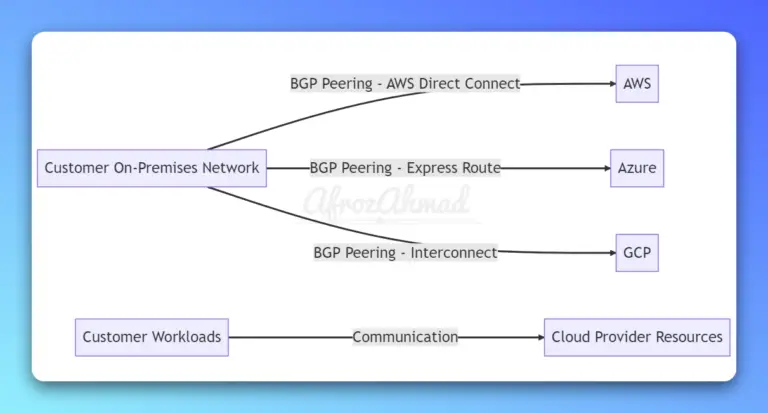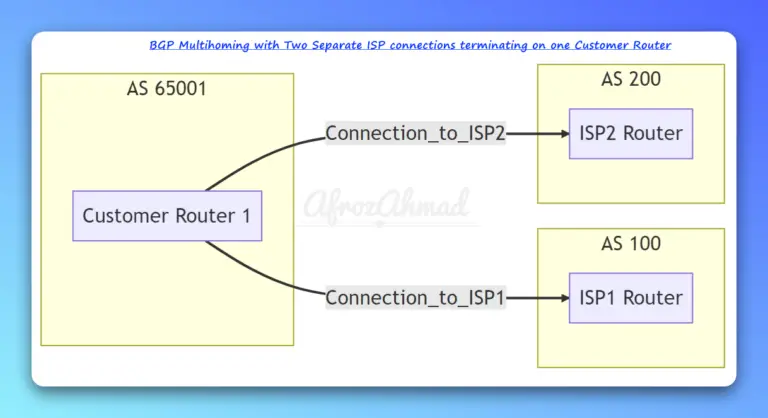The landscape of Border Gateway Protocol (BGP) reachability and robust network design has evolved considerably since this post was first published. While the fundamental principles remain, modern networks demand heightened attention to scalability, security, and observability. Let’s revisit a classic BGP reachability scenario and update our approach with current best practices.
Consider the following scenario, a common setup from years past, but still useful for illustrating core BGP challenges:
R1
|
|
|
R2--FR CLOUD--R6
|
|
|
R5In this classic topology, R1 and R2 are connected to R6 via a Frame-relay cloud (a technology largely superseded by modern MPLS, SD-WAN, or direct peering, but conceptually still represents an intermediate layer). OSPF Area 0 is running between R1, R2, and R6, with R6 advertising a default route into the OSPF domain. R2 is in BGP AS 100, R6 is in BGP AS 200, and R5 is in BGP AS 54. Notably, R1 does not participate in BGP routing.
The Challenge: A Classic BGP Blackhole Scenario
The problem arises when reachability is lost to certain BGP networks, specifically those learned by R2 from R5 (AS 54), if R2’s primary Frame Relay connection to R6 goes down. In such an event, R2’s traffic destined for R6, or networks reachable via R6, must transit R1. However, since R1 does not participate in BGP, it lacks specific BGP routes for destinations learned via AS 200 or AS 54. Consequently, while BGP Network Layer Reachability Information (NLRI) might be successfully propagated (e.g., if R2 is still advertising prefixes from AS 54), traffic attempting to reach these destinations would be blackholed when it reaches R1.
This situation highlights a critical design consideration: the interplay between your Interior Gateway Protocol (IGP) and your Exterior Gateway Protocol (EGP).
The Original Solution: BGP-to-OSPF Redistribution (with Modern Caveats)
To resolve the issue in the original scenario, BGP was redistributed into OSPF (the IGP). Specifically, R2 was configured to redistribute BGP information learned from AS 54 into OSPF. This allows R1 to learn routes to AS 54 prefixes via OSPF from R2, even though R1 is not a BGP speaker itself. For traffic in the opposite direction (from R6 towards AS 54), the default route originated by R6 into OSPF typically handles it, pushing traffic towards R2. The original syntax used on R2 was:
router ospf 1
redistribute bgp 100 subnets route-map BGP2OSPF
ip as-path access-list 1 permit ^54_
route-map BGP2OSPF permit 10
match as-path 1Here, the `^54_` in the AS-PATH access-list is a regular expression that matches any AS-PATH originating with `54` (the caret `^` signifies the start of the AS-PATH, and the underscore `_` acts as a delimiter or a space, ensuring that ’54’ is the full AS at that position, not part of a larger AS number like ‘540’). This effectively redistributes only those BGP routes whose origin AS is 54 into OSPF.
Modern Best Practice Alert (2025): While this technique effectively solves the immediate reachability problem, redistributing a large number of BGP routes into an IGP like OSPF is generally discouraged for scalability and stability reasons in modern enterprise or service provider networks. OSPF databases can become unwieldy, convergence times can increase, and processor/memory utilization on routers can spike. The risk of OSPF instability due to a large influx of external routes is significant. This is particularly true for full BGP tables, though even selective redistribution warrants careful consideration.
Recommended Modern Approaches to BGP-IGP Integration
Instead of wide-scale BGP redistribution into OSPF, modern network designs typically favor more controlled methods:
- Summarization and Default Routes: As R6 already does, advertising a default route (`0.0.0.0/0`) into the IGP from your border routers (like R6 and potentially R2) is often sufficient. This directs all traffic for unknown external destinations to the appropriate BGP-speaking edge device. For internal networks behind an edge router (like R2’s local AS 54 routes), aggressive summarization before redistribution or simply advertising these specific local networks into OSPF can be done.
- Selective Route Advertisement: If specific external prefixes absolutely *must* be known by non-BGP speaking routers within the IGP, use very strict route-maps and prefix-lists to limit redistribution to only those essential prefixes. This is a surgical approach, not a broad brush.
- BGP-Free Core/Edge Designs: Many large networks aim for a “BGP-free core” where the IGP handles internal routing, and BGP is only run on edge routers and route reflectors. This simplifies the IGP and segregates external routing complexity.
- Next-Hop Self for iBGP: For iBGP peers, ensuring `next-hop-self` is configured prevents blackholing by forcing the BGP next-hop to be the iBGP speaker itself, ensuring the IGP can resolve it. (This wasn’t directly the issue in the original scenario but is a common BGP-IGP interaction point).
- BGP Link-State (BGP-LS): In very large and complex multi-domain environments, BGP-LS (RFC 7752) allows BGP to carry IGP topology information, enabling controllers or SDN solutions to have a unified view of the network without redistributing individual prefixes. This is a more advanced solution for specific architectures.
BGP Security in 2025: RPKI, BGPsec, and MANRS Compliance
Beyond reachability, securing BGP has become paramount. The internet relies on BGP, making it a critical attack surface for route hijacks, leaks, and other forms of traffic manipulation. As a senior network engineer, neglecting these aspects in 2025 is no longer an option:
- Resource Public Key Infrastructure (RPKI): RPKI provides a cryptographically secure way to verify the origin of BGP routes. It allows network operators to create Route Origin Authorizations (ROAs) which state that a specific Autonomous System (AS) is authorized to originate specific IP prefixes. Implementing RPKI validation on your BGP routers (e.g., using a Route Origin Validator) is a fundamental step to protect against accidental or malicious prefix hijacking. Most major ISPs now filter invalid routes.
- BGPsec: An extension to BGP that provides cryptographic verification of the entire AS Path, ensuring that the path a route has traversed is authorized. While RPKI validates the origin, BGPsec aims to validate the *path*. Adoption is slower than RPKI due to complexity and computational overhead but remains an important future direction.
- MANRS (Mutually Agreed Norms for Routing Security): MANRS is an industry-driven initiative promoting best common practices for routing security. Adhering to MANRS actions (Filtering, Anti-spoofing, Coordination, Global Validation, and Incident Response) significantly improves the security and resilience of the global routing system. Compliance is increasingly becoming a benchmark for trusted network operators.
Ensure your BGP configurations include origin validation (RPKI) and robust filtering based on prefix-lists and AS-path access-lists to accept only valid and expected routes from your peers.
Observability and BGP Monitoring Best Practices 2025
Troubleshooting BGP reachability issues proactively and reactively demands robust observability. In 2025, this goes beyond simple `show ip bgp` commands:
- Real-time BGP Monitoring Platforms: Leverage dedicated BGP monitoring tools (e.g., open-source like BIRD, commercial solutions like Kentik, Catchpoint, ThousandEyes) that provide real-time visibility into BGP routing tables, peer state changes, route advertisements, and withdrawals across your network and even globally.
- Route Analytics: Use tools that can ingest BGP routing information (from route servers, peering DBs, or your own routers) to perform analytics, detect anomalies (like sudden route withdrawals, new prefix origins, or path changes), and visualize peering health.
- Telemetry and Streaming Data: Modern network devices support streaming telemetry for BGP, providing high-frequency, granular data that can be fed into analytics platforms for immediate anomaly detection and faster incident response than traditional polling.
- Automated Pre-flight Checks: Before deploying BGP changes, utilize automation tools to perform pre-flight checks, verifying route-map logic, prefix-list accuracy, and potential impacts on reachability.
Conclusion
The core problem of BGP reachability in a mixed IGP/BGP environment, as illustrated by the R1-R2-R6 scenario, remains relevant. However, the solutions we implement today must consider the broader implications of scalability, security, and the need for comprehensive observability. While selective redistribution might offer a quick fix, understanding its limitations and embracing modern best practices like aggressive summarization, BGP security protocols (RPKI, MANRS), and advanced monitoring tools are crucial for building resilient, secure, and future-proof networks. Always remember that a robust network is one that not only functions but also offers visibility, security, and adapts to evolving demands.
- Justifying a $50k or even Higher Annual Switch Upgrade: What Must-Have Features Are We Missing? - November 13, 2025
- Managing Overlapping Private IPs in Multi-Client Site-to-Site VPNs: Best Practices? - November 7, 2025
- Epson EpiqVision Flex CO-W01 Projector Review - February 21, 2025



